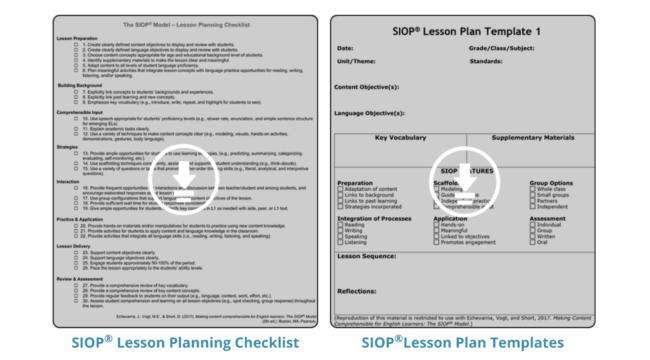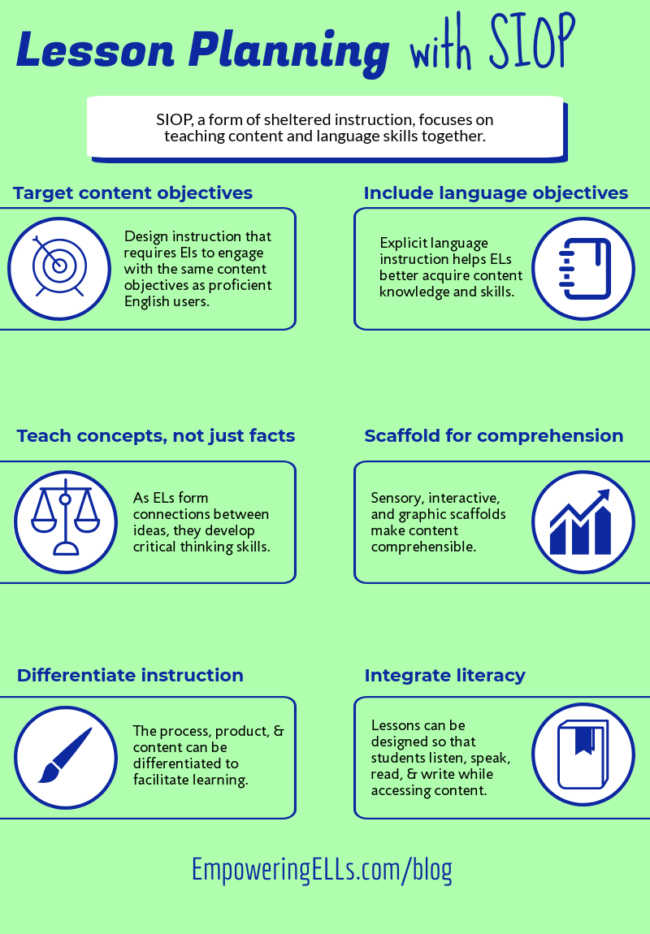Sheltered instruction is the practice of simultaneously:
- teaching content
- and cultivating language development.
One framework that teachers can use to design sheltered instruction lessons is the Sheltered Instruction Observation Protocol (SIOP) created by Short, Vogt, and Echevarria more than 20 years ago. The SIOP Model is empirically tested and research-based, which is why it’s used readily all over the world.
Though the SIOP model is not a step-by-step process, it provides a framework for teaching content and language instruction. But here is a link if you’re looking for an official SIOP-created lesson planning template.
In Making Content Comprehensible for English Learners: The SIOP Model (5th Edition) (SIOP Series), Echevarria, Vogt, and Short recommend that teachers design lessons that teach content and language simultaneously by incorporating the following items below.
1. Identify Content Objectives
Content objectives prevent learning experiences from being mere activities. They need to be clearly defined in language that is friendly for students, clearly displayed, and reviewed with students.
For example, one of the science objectives from the Middle Years Program of the International Baccalaureate Program is for students to develop the skill of designing a lab experiment.
Instead of saying that ELs can’t successfully complete this task, Mr. Adam scaffolded his instruction to ensure that the content objective was reached. We co-designed a lab experiment template to teach students how to design, carry out, and analyze data, which were the content objectives, which I will describe later in this blog.
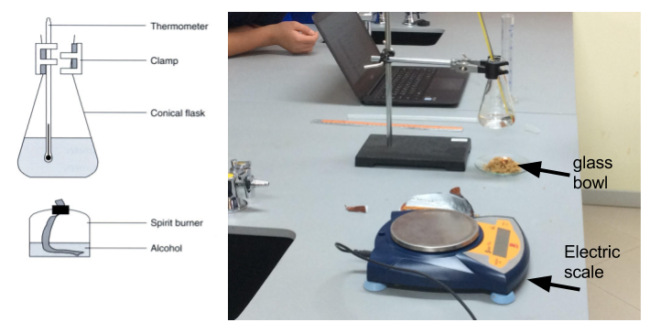
2. Integrate Language objectives
Integrating both content and language objectives ensures that learning content is not the only focus in content classes. Learning a language and content detail can occur in the same class.
These standards should also be clearly defined, displayed, and reviewed with students.
As an English language development teacher, having language objectives helps focus my time when I’m supporting in the content classes – both on the content that students need to learn and the language they need to acquire to engage with the content.
I use both the WIDA Can Do Booklet 6-8 and the IB MYP Phase 4 standards in Mr. Adam’s science class. Here are two examples of objectives that help:
WIDA: Writing Level 4 Expanding – produce content-related reports
IB MYP Phase 4 – organize information and ideas into a structured text; use a wide range of cohesive devices
3. Teach Concepts
Teaching with concepts helps elevate the rigor of content lessons. Students learn to think abstractly, form connections between ideas, and form conclusions. Conceptual teaching empowers ELs to develop critical thinking instead of just learning facts. Concepts must be age appropriate, however, and suitable for the educational background of students.
In the example of Mr. Adam’s science lab experiment, the concept is relationships. He wanted students to design, carry out, and analyze data from a lab experiment to understand the concept of relationships.
More specifically, he wanted students to see the relationship between the calories and energy level in the snacks that students eat. Therefore, he created a task that guided them through a lab where they gathered data on the energy content of food. Students internalized the concept much better through this hands-on activity than they would have from a static lecture.
4. Scaffold for Comprehension
Use various forms of scaffolds such as sensory, interactive, and graphic support to make instruction and content comprehensible. Scaffolding for comprehensible input means that ELs are expected the learn the same material, but the process they use to acquire content knowledge might be different than that of students who are proficient in English.
To scaffold the process of designing and carrying out the experiment, I annotated Google Drawing images that I later inserted into the lab format. This format was given only to the ELs, but it is such a useful tool in general that many non-ELs also requested access to guide their work. The image, tables, and sentence starters help the students visualize essential information from the lesson.
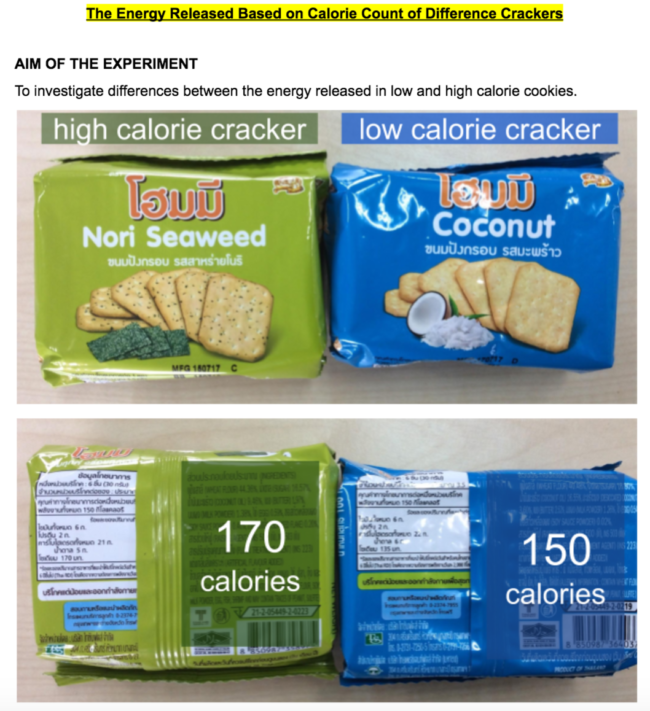
5. Differentiate Instruction
Some content teachers think that rigorous content has to be watered down for ELs. The opposite is true. Content can be adapted to meet all proficiency levels. Not differentiating the content means ELs are not being given access to grade-level expectations.
When teaching ELs, focus on what they can do rather than cannot do. In Mr. Adam’s class, there are ELs who are still beginning English users, yet they’re intellectually capable of engaging in critical thinking. So I differentiated the lab report to help them engage with the experiment. One way I did so was by creating a data-collection table that was color coded to match the two different type of crackers students were experiment with (see image below).
With this differentiation, ELs engaged in the same rigorous task, but they engaged in the process in different ways than proficient English users. When done correctly, differentiation doesn’t dumb the content down, it makes it more accessible. This graphic scaffold, for example, helps ELs as they engage in the experiment, but it doesn’t do the work for them.
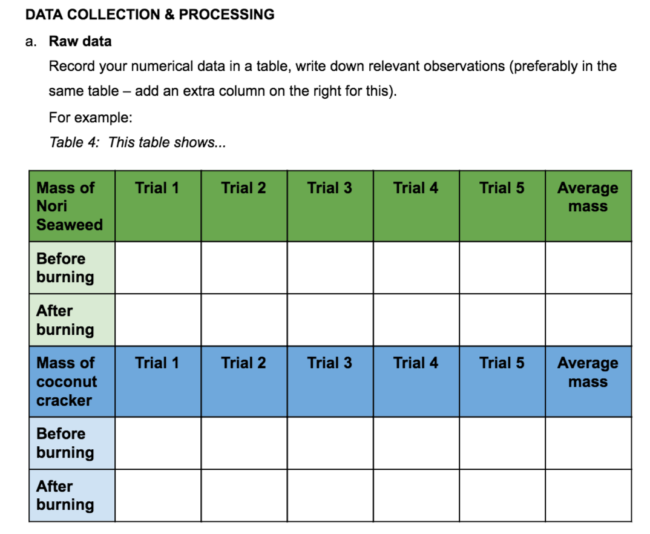
6. Integrated Literacy
Content classes provide rich contexts for using language authentically. As students acquire content, they employ all the language domains: listening, reading, speaking, and writing. Doing so both develops language skills and serves as a means to learn content.
Mr. Adam’s science experience is a perfect opportunity to organize writing using science-specific language and practice thinking like a scientists. ELs are actively using language in specific ways that meet the text features of a lab report such as forming a hypothesis, writing a research question, and analyzing data.
Mr. Adam is not waiting for ELs to have perfect English to allow them to do the experiment. He knows that the process itself makes learning language more authentic for them.
Takeaways
The SIOP model offers a framework for lesson planning – not specific steps for how to do so. Each element of the sheltered instruction framework is like a promise we keep to ELs that despite their growing language skills, they will be given access to the same content. This isn’t an empty promise because we intentionally build in more ways to scaffold their acquisition of content.
If you would like to learn more about the SIOP model as one way to implement sheltered instruction, Dr. Jana Echarvaria’s No More Low Expectations for English Learners (Not This but That) is a fantastic quick read on the topic. By purchasing this book, you also support the blog.
Echevarria, J., Vogt, ME, & Short, D. (2017). Making Content Comprehensible for English Learners: The SIOP Model. Fifth Edition. New York: Pearson.
Freeman, D. and Y. Freeman. 1988. Sheltered English Instruction. Washington, DC: U.S. Department of Education.
Nora, J., & EchevariÌa, J. (2016). No More Low Expectations for English Learners. Duke, N. K., & Keene, E. O. (Eds.). Heinemann, 2016.

